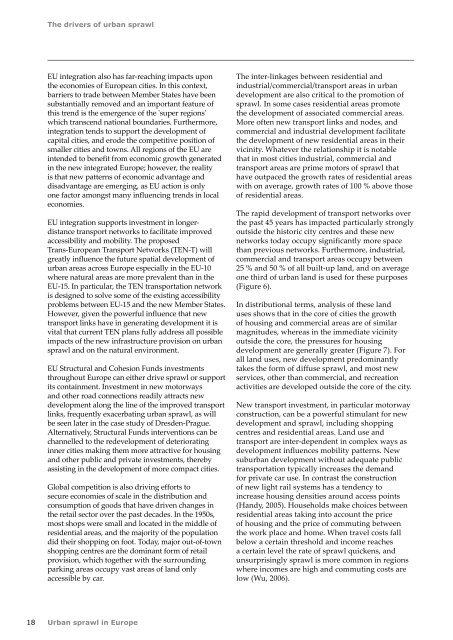Session 1 - Montefiore
Session 1 - Montefiore
Session 1 - Montefiore
Create successful ePaper yourself
Turn your PDF publications into a flip-book with our unique Google optimized e-Paper software.
18<br />
The drivers of urban sprawl<br />
EU integration also has far-reaching impacts upon<br />
the economies of European cities. In this context,<br />
barriers to trade between Member States have been<br />
substantially removed and an important feature of<br />
this trend is the emergence of the 'super regions'<br />
which transcend national boundaries. Furthermore,<br />
integration tends to support the development of<br />
capital cities, and erode the competitive position of<br />
smaller cities and towns. All regions of the EU are<br />
intended to benefit from economic growth generated<br />
in the new integrated Europe; however, the reality<br />
is that new patterns of economic advantage and<br />
disadvantage are emerging, as EU action is only<br />
one factor amongst many influencing trends in local<br />
economies.<br />
EU integration supports investment in longerdistance<br />
transport networks to facilitate improved<br />
accessibility and mobility. The proposed<br />
Trans-European Transport Networks (TEN-T) will<br />
greatly influence the future spatial development of<br />
urban areas across Europe especially in the EU-10<br />
where natural areas are more prevalent than in the<br />
EU-15. In particular, the TEN transportation network<br />
is designed to solve some of the existing accessibility<br />
problems between EU-15 and the new Member States.<br />
However, given the powerful influence that new<br />
transport links have in generating development it is<br />
vital that current TEN plans fully address all possible<br />
impacts of the new infrastructure provision on urban<br />
sprawl and on the natural environment.<br />
EU Structural and Cohesion Funds investments<br />
throughout Europe can either drive sprawl or support<br />
its containment. Investment in new motorways<br />
and other road connections readily attracts new<br />
development along the line of the improved transport<br />
links, frequently exacerbating urban sprawl, as will<br />
be seen later in the case study of Dresden-Prague.<br />
Alternatively, Structural Funds interventions can be<br />
channelled to the redevelopment of deteriorating<br />
inner cities making them more attractive for housing<br />
and other public and private investments, thereby<br />
assisting in the development of more compact cities.<br />
Global competition is also driving efforts to<br />
secure economies of scale in the distribution and<br />
consumption of goods that have driven changes in<br />
the retail sector over the past decades. In the 1950s,<br />
most shops were small and located in the middle of<br />
residential areas, and the majority of the population<br />
did their shopping on foot. Today, major out-of-town<br />
shopping centres are the dominant form of retail<br />
provision, which together with the surrounding<br />
parking areas occupy vast areas of land only<br />
accessible by car.<br />
Urban sprawl in Europe<br />
The inter-linkages between residential and<br />
industrial/commercial/transport areas in urban<br />
development are also critical to the promotion of<br />
sprawl. In some cases residential areas promote<br />
the development of associated commercial areas.<br />
More often new transport links and nodes, and<br />
commercial and industrial development facilitate<br />
the development of new residential areas in their<br />
vicinity. Whatever the relationship it is notable<br />
that in most cities industrial, commercial and<br />
transport areas are prime motors of sprawl that<br />
have outpaced the growth rates of residential areas<br />
with on average, growth rates of 100 % above those<br />
of residential areas.<br />
The rapid development of transport networks over<br />
the past 45 years has impacted particularly strongly<br />
outside the historic city centres and these new<br />
networks today occupy significantly more space<br />
than previous networks. Furthermore, industrial,<br />
commercial and transport areas occupy between<br />
25 % and 50 % of all built-up land, and on average<br />
one third of urban land is used for these purposes<br />
(Figure 6).<br />
In distributional terms, analysis of these land<br />
uses shows that in the core of cities the growth<br />
of housing and commercial areas are of similar<br />
magnitudes, whereas in the immediate vicinity<br />
outside the core, the pressures for housing<br />
development are generally greater (Figure 7). For<br />
all land uses, new development predominantly<br />
takes the form of diffuse sprawl, and most new<br />
services, other than commercial, and recreation<br />
activities are developed outside the core of the city.<br />
New transport investment, in particular motorway<br />
construction, can be a powerful stimulant for new<br />
development and sprawl, including shopping<br />
centres and residential areas. Land use and<br />
transport are inter-dependent in complex ways as<br />
development influences mobility patterns. New<br />
suburban development without adequate public<br />
transportation typically increases the demand<br />
for private car use. In contrast the construction<br />
of new light rail systems has a tendency to<br />
increase housing densities around access points<br />
(Handy, 2005). Households make choices between<br />
residential areas taking into account the price<br />
of housing and the price of commuting between<br />
the work place and home. When travel costs fall<br />
below a certain threshold and income reaches<br />
a certain level the rate of sprawl quickens, and<br />
unsurprisingly sprawl is more common in regions<br />
where incomes are high and commuting costs are<br />
low (Wu, 2006).











